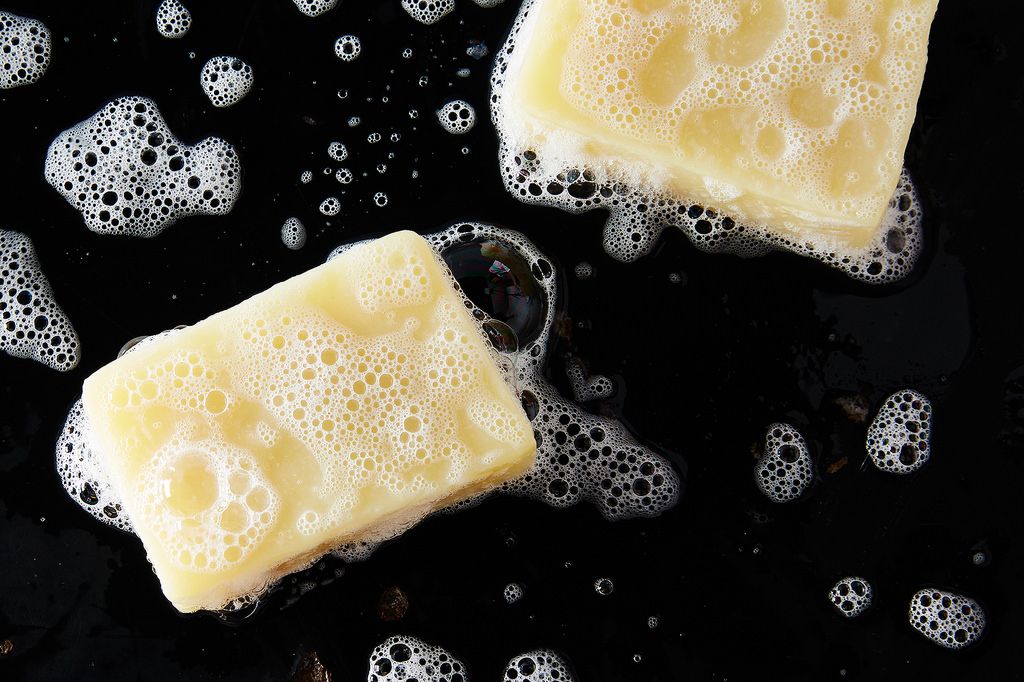
With a few key tools and pieces of knowledge, soapmaking is no harder than most of the
ambitious cooking projects we take on—and the results are well worth it. Once you have a base recipe down, you can play with fragrance combinations and other add-ins to customize each batch.
What you’ll need:
Ingredients:16 ounces coconut oil
14 ounces palm oil, preferably from a responsible source
21 ounces olive oil, the cheapest you can find
19 ounces distilled water
sodium hydroxide (lye), a 2 pound container of which will make about 4 batches of soap
7 teaspoons essential oil or fragrance oil (optional)
14 ounces palm oil, preferably from a responsible source
21 ounces olive oil, the cheapest you can find
19 ounces distilled water
sodium hydroxide (lye), a 2 pound container of which will make about 4 batches of soap
7 teaspoons essential oil or fragrance oil (optional)
Tools:Large heat-safe vessel such as an enamelware soup pot*
Measuring cup or small bowl*
Heat-safe vessel, ideally with a handle, such as a heavy glass pitcher*
Silicone spatula or other stirring utensil*
Instant-read thermometer*
Immersion blender*
Scale that can measure in grams and ounces
Soap mold or a 9-inch by 12-inch baking pan*
Plastic wrap (if using a baking pan)
Waxed paper or parchment paper
Teaspoon and additional measuring cup (if using fragrance)
Old towel or blanket
Sharp, thin knife
Rubber gloves
Safety goggles
Measuring cup or small bowl*
Heat-safe vessel, ideally with a handle, such as a heavy glass pitcher*
Silicone spatula or other stirring utensil*
Instant-read thermometer*
Immersion blender*
Scale that can measure in grams and ounces
Soap mold or a 9-inch by 12-inch baking pan*
Plastic wrap (if using a baking pan)
Waxed paper or parchment paper
Teaspoon and additional measuring cup (if using fragrance)
Old towel or blanket
Sharp, thin knife
Rubber gloves
Safety goggles
*Any tools that touch lye should NOT be reused for cooking!
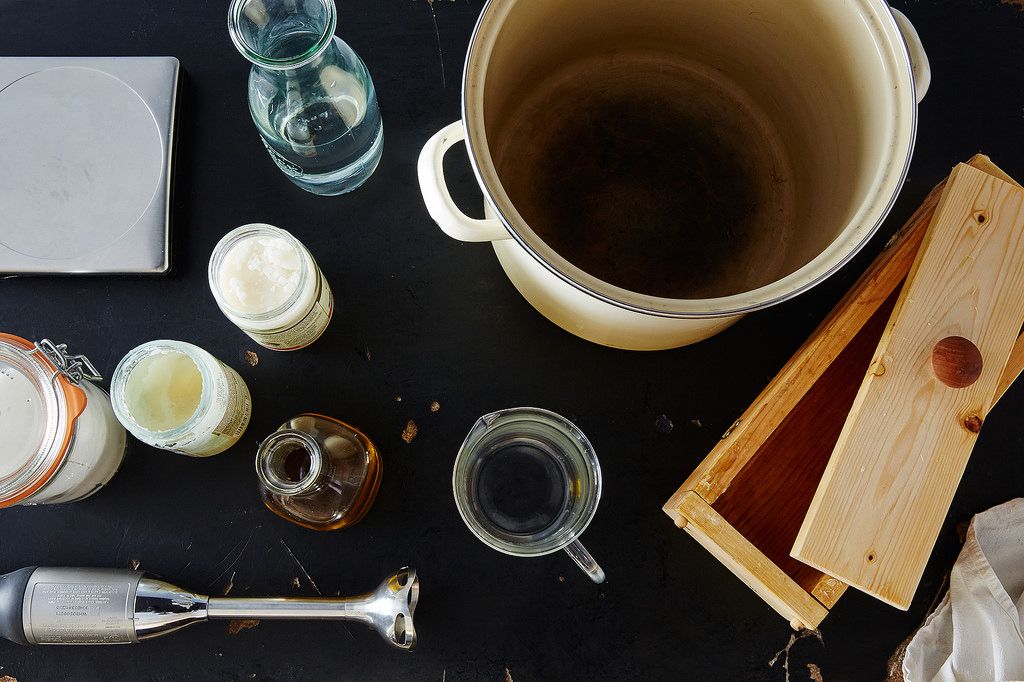
Notes on safety, lye, and sourcing tools:
Soapmaking requires caution because of the use of lye, which is very caustic and should never come in contact with your skin. Always wear gloves, eye protection, and long sleeves, and work in a well-ventilated area. Keep your face away from the lye as you mix it, and keep pets and children away from it as it's cooling. But don’t worry about your soap—all the lye will be used up in the saponification process (the reaction between lye and fat that makes soap) and none will remain in the finished product. If you're at all concerned about working with lye, an easy way to ensure none remains in your finished soap is to use a little more fat than the amount that would exactly be cancelled out by the saponification process, which is called "superfatting," and will almost definitely be covered in any calculator, chart, or other resource used for developing soap recipes.
For soapmaking, I recommend purchasing lye marked as "pure" or "food grade," and shop for it online rather than in stores. I don't recommend buying lye that's specifically marketed as a drain opener (its other primary use) for this process because it might have other ingredients as well. It comes in different forms, little beads or little flakes; it doesn't matter which you choose for this process. (Interestingly, lye is also used in some recipes. I've haven't done it yet, but I've been wanting to try making pretzels with a lye bath.)
Although soapmaking becomes cost-effective if you do it often, making your first batch can be a bit of an investment since you none of the tools will be food-safe after touching the lye. I’ve linked above to low-priced options for many of the tools required, and thrift stores are also a great option for items like the pitcher and pot. Oils for soapmaking can be purchased in 7 pound bags, which will keep costs down quite a bit if you're making more than one batch.
How to make soap at home:
1. Mix the lye. Put on your rubber gloves and safety goggles, and set up in a very well-ventilated area such as next to an open window. Use your scale and measuring cup to carefully weigh 201 grams of sodium hydroxide and set it aside. Then, weigh 19 ounces of distilled water into your glass pitcher or other sturdy, heat-safe vessel. Now, carefully pour the sodium hydroxide into the pitcher of water, and stir just long enough to make sure it all dissolves. This creates a chemical reaction that heats the water to over 200° F and produces strong fumes at first, so work quickly and be extra careful here—I try to hold my breath while I stir. (Safety note: Always work in this order and add lye to water. Never add water to lye, which can cause spattering of the hot lye solution or even an explosion.)
The lye now needs to cool to below 100° F. I usually place mine outside on my porch to speed up this process. Depending on how cold out it is, it can take between 30 and 90 minutes for the lye to cool, which is why I recommend doing this step first.
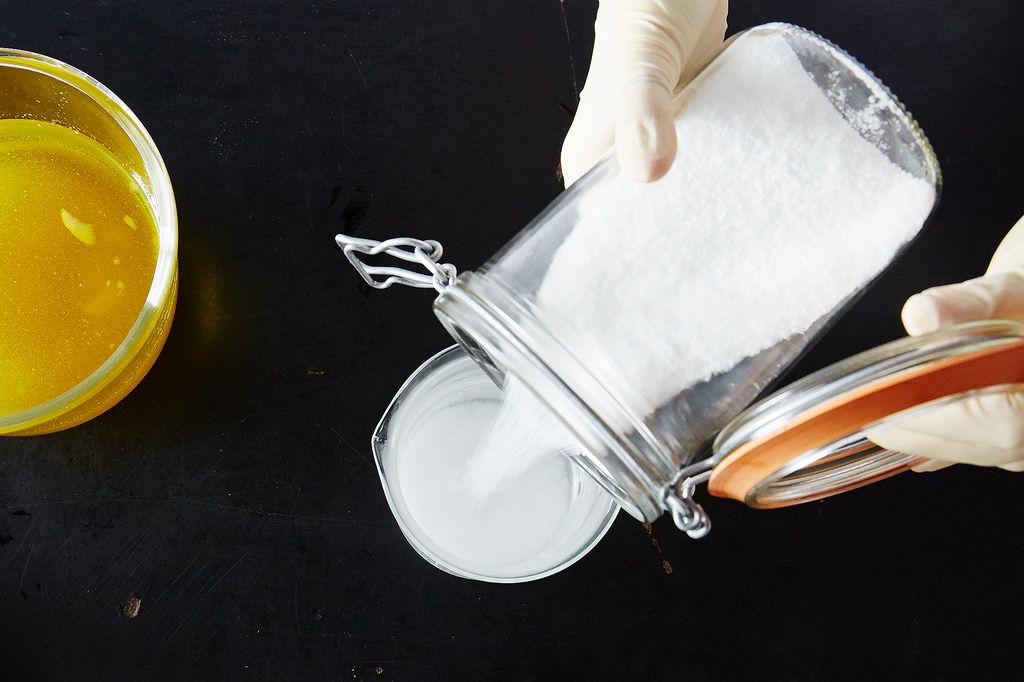
2. Prepare the mold and measure out fragrance. If you're using a wooden loaf mold or a baking pan, carefully line the inside with waxed paper or parchment paper to make the soap easy to remove later. I often use some masking tape to help hold everything in place. If you use a silicone mold, you can skip this step.
If you like the simplicity of plain rectangular soap bars and think you’ll make more than a couple batches of soap, having a wooden loaf mold like the one shown here makes the process easy and consistent. (I’ve found eBay and Etsy to be good sources for wooden versions at lower prices.) Other options include silicone and PVC plastic molds, which come in many shapes and patterns. If you’re not ready to invest yet, a 9 by 12-inch baking pan that your kitchen is willing to part with should also work just fine for this recipe.
Now is also a good time to measure out your essential oils into an extra measuring cup, for ease of adding them later. Blending fragrances is one of my favorite parts of soapmaking. For this batch, I used 5 teaspoons of orange essential oil and 2 of sandalwood. Synthetic fragrance oils also work well and are generally less expensive than pure essential oils. You can also opt to make unscented soap and simply leave this ingredient out.
3. Melt and mix the oils. You can now prepare the blend of oils to which you’ll add the lye. If you're using oils that are solid at room temperature, such as the coconut and palm oils in this recipe, you’ll first need to melt them so they can be poured, either by placing the container in a saucepan of simmering water or by melting them in the microwave.
Once your oils are in a liquid state, place your large pot on the scale and weigh (or re-weigh, if you've already done so) the each oil into it for precision. Stir everything together and then check the temperature with a heat-safe thermometer. For the next step, the oils need to be between 80 and 100° F. I often find that mine are already in the correct range from being melted, but if not, place the pot on the stove over low heat until the oils reach the proper temperature or set aside to cool down.
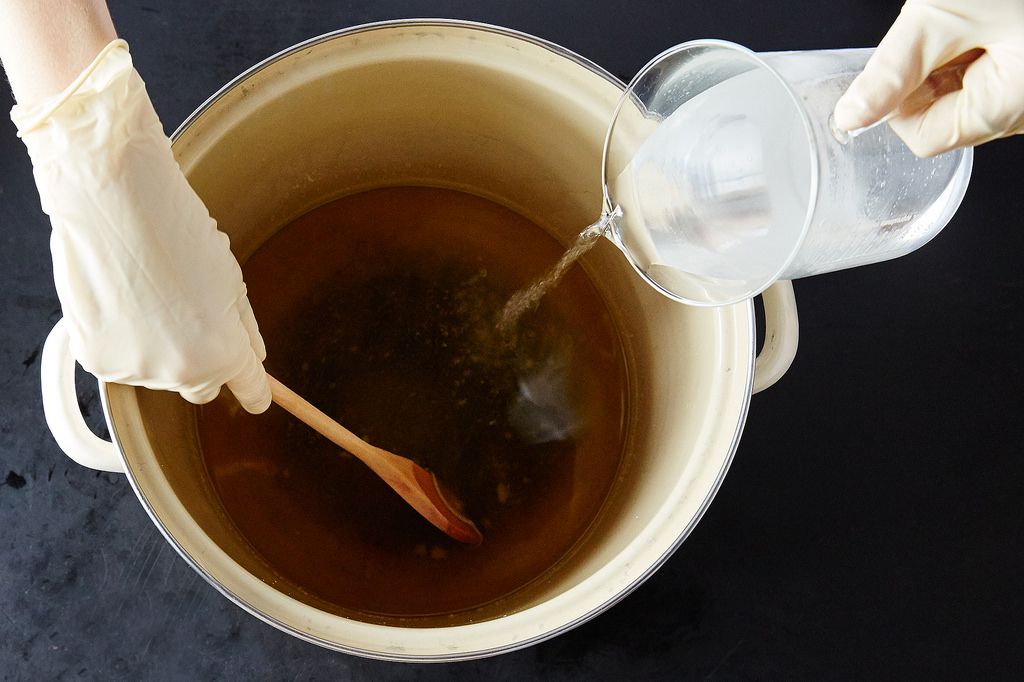
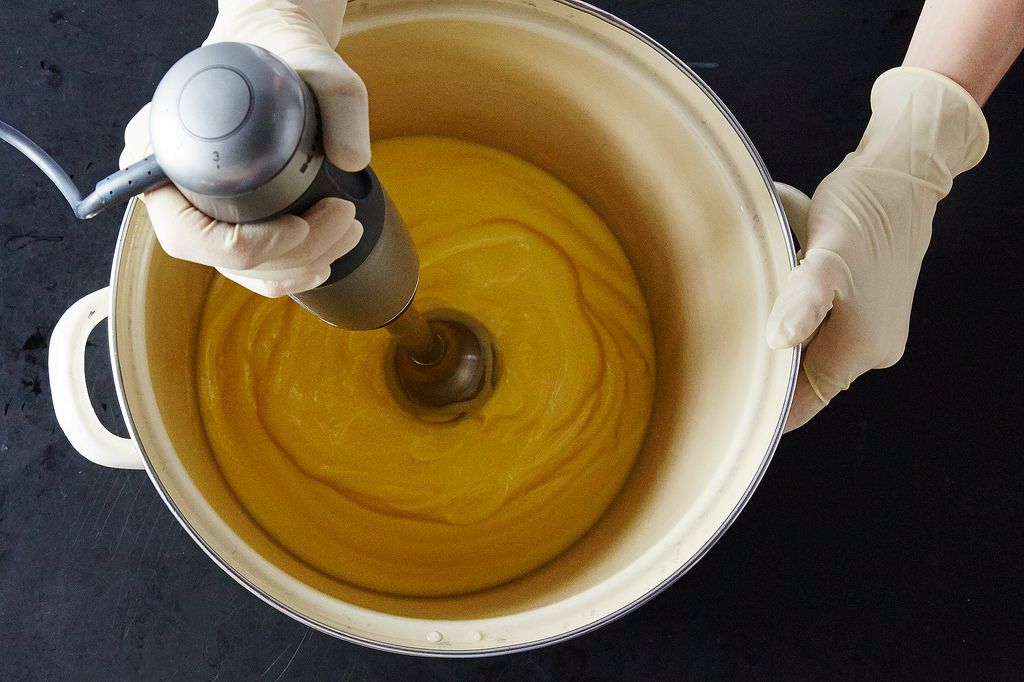
4. Blend and pour your soap.
When both your lye and your oil mixture are between 80 and 100° F, you’re ready to blend. After removing the pot from the heat to a trivet or heat-safe surface, put your gloves and eye protection back on and carefully pour the lye into the pot of oil. They’ll begin to react with each other, turning the mixture cloudy. Begin blending with your immersion blender, and over the next 3 to 5 minutes you’ll see the mixture become thicker and more opaque. You're aiming for a mixture with the consistency of a runny pudding. If you lift the blender out and let some drips fall across the surface of the mixture, you should see them leave a visible pattern, called “trace,” before sinking back in.
Once the soap mixture has reached trace, stir in the fragrance oil, if using, until blended. Carefully pour the finished mixture into your lined soap mold, and cover with the lid (or plastic wrap, if your mold has no lid). Being sure to keep it level, wrap the whole thing in a towel or blanket to insulate it, and leave undisturbed in an airy out-of-the-way place like a shelf for 24 hours.
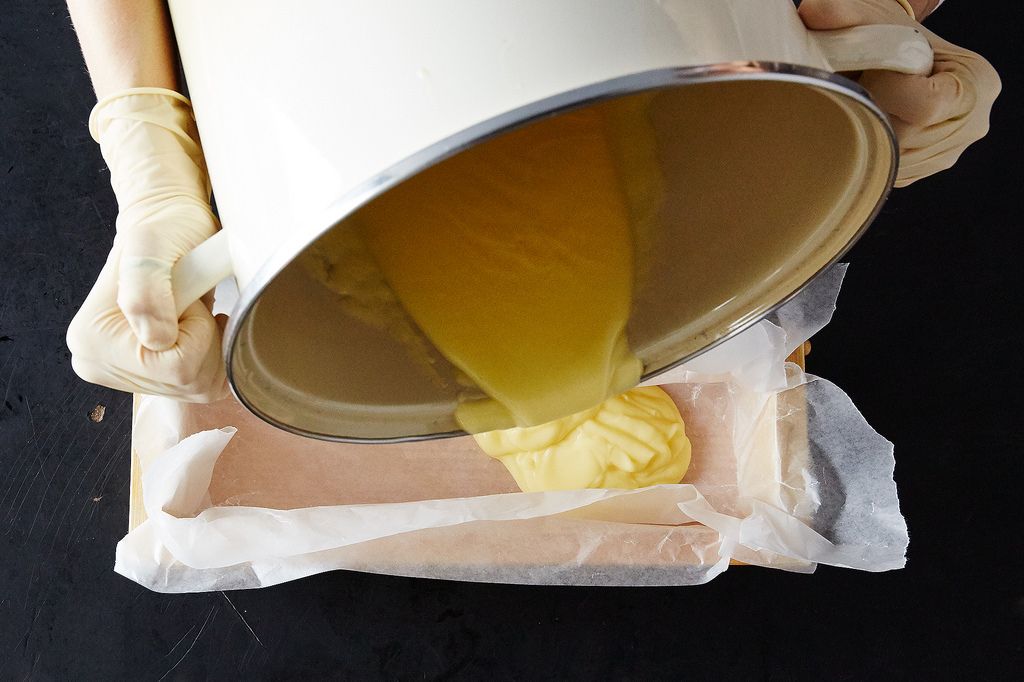
6. Cut and cure your soap. When your soap has hardened in the mold for 24 hours, it’s ready to be removed; many wooden loaf molds have fold-down sides or removable bottoms to make this process easier. If you’ve used a baking pan, you may need to use a knife to help pry the soap loaf out. Cut the loaf into bars with a sharp knife. (I use a ruler and score the top of the loaf before cutting to make sure everything stays straight and even. I like generous bars, so I cut them about an inch thick.)
Your work is now done, but the bars need to cure for 4 to 6 weeks before being used. This time allows the water in the bars to fully evaporate, resulting in a harder and milder soap. Leave the soap to cure on a paper bag or baking rack in the same airy location. If you use a paper bag, turn the bars once or twice during the curing time to make sure all sides are exposed to air.
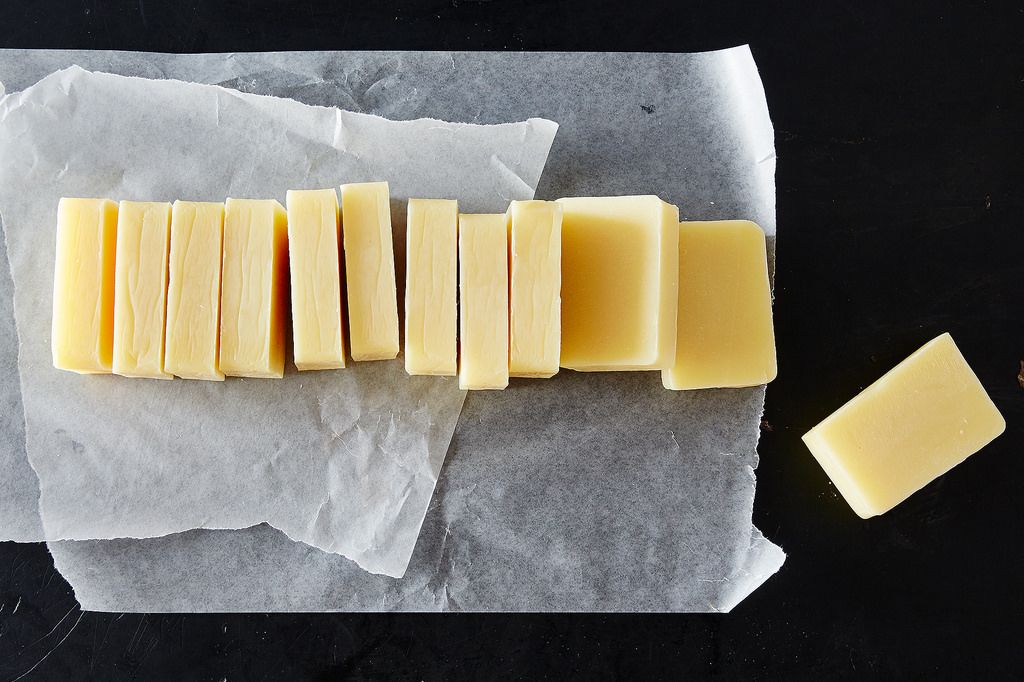
Cleaning up:The pitcher, measuring cup, and spatula just need to be thoroughly rinsed with water. For the pot with raw soap residue in it, I usually wipe it out first with paper towels before washing it with dish soap and water. Use any tools that touched the lye only for soapmaking, and store them away from the kitchen to prevent any chance of confusion.
http://food52.com/blog/12919-how-to-make-soap-at-home-even-if-you-failed-chemistry?utm_term=5915359&utm_source=Sailthru&utm_medium=email&utm_campaign=20160118_eds_DIY




Комментариев нет:
Отправить комментарий